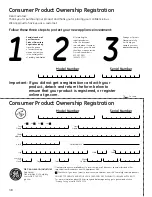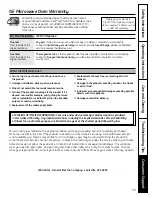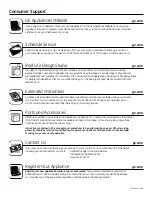
ge.com
25
Appetizers/sauces/soups
Cooking Appetizers: Tips and Techniques
Recommended
■
Crisp crackers, such as melba toast, shredded wheat and
crisp rye crackers are best for microwave use. Wait until
party time to add the spreads. Place a paper towel under
the crackers while they cook in the microwave oven to
absorb extra moisture.
■
Arrange individual appetizers in a circle for even cooking.
■
Stir dips to distribute heat and shorten cooking time.
Cooking Sauces: Tips and Techniques
■
Use a microwavable casserole or glass measuring cup
that is at least 2 or 3 times the volume of the sauce.
■
Sauces made with cornstarch thicken more rapidly than
those made with flour.
■
Cook sauces made with cornstarch or flour uncovered so
you may stir them 2 or 3 times during cooking for a smooth
consistency.
■
To adapt a conventional sauce or gravy recipe, reduce
the amount of liquid slightly.
Cooking Soups: Tips and Techniques
■
Cook soups in a microwavable dish which holds double
the volume of the recipe ingredients to prevent boil-over,
especially if you use cream or milk in the soup.
■
Generally, cover microwaved soups with VENTED plastic
wrap or a microwavable lid.
■
Cover foods to retain moisture. Uncover foods to retain
crispness.
■
Avoid overcooking by using the minimum suggested time.
Add more time, if necessary, only after checking the food.
■
Stirring occasionally will help blend flavors, distribute heat
evenly, and may even shorten the cooking time.
■
When converting a conventional soup recipe to cook in
the microwave oven, reduce the liquid, salt and strong
seasonings.
Not Recommended
■
Appetizers with a crisp coating or puff pastry are best done
in a conventional oven with dry heat.
■
Breaded products can be warmed in the microwave oven,
but will not come out crisp.
Meat
Cooking Meat: General Directions
■
Prepare the meat for cooking.
– Defrost completely.
– Trim off excess fat to avoid spattering.
– Place the meat, fat side down, on a microwavable rack
in a microwavable dish.
– Use oven cooking bag for less tender cuts of meat.
– Arrange the meat so that thicker portions are toward
the outside of the dish.
– Cover the meat with waxed paper to prevent spattering.
■
Tend the meat as it cooks.
– Drain juices as they accumulate to reduce spattering
and keep from overcooking the bottom of the meat.
– Shield thin or bony portions with strips of foil to prevent
overcooking.
NOTE: Keep the foil at least 1 inch from the oven walls,
and do not cover more than one-third of the meat with foil
at any one time.
■
Let the meat stand covered with foil 10–15 minutes after
you remove it from the oven. The internal temperature
of the meat may rise from 5–10° F during standing time.
The Meat Cooking Chart on the next page provides detailed
directions, Power Level, and Cooking Time settings for most
cuts of meat.
Safety Instructions
Operating Instructions
Car
e and Cleaning
Tr
oubleshooting Tips
Consumer S
uppor
t






























